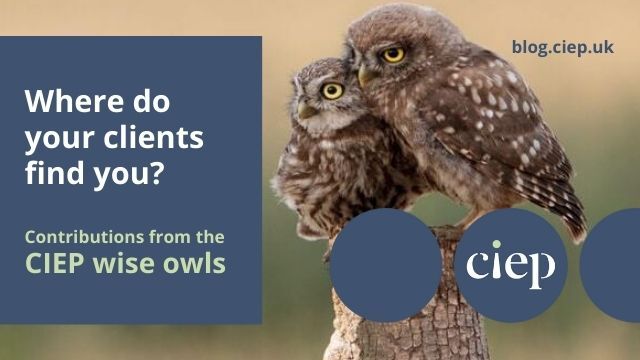We asked our parliament of wise owls, all Advanced Professional Members, where new clients have found them, and where they focus their marketing efforts.
 Liz Jones
Liz Jones
My clients mostly find me via word of mouth, repeat business, the CIEP Directory, my website, LinkedIn and Twitter. Repeat business is probably the most important one from a financial point of view, and it’s one reason that I make sure to treat all my clients the way I would want to be treated – by offering clear communication, reliability and dedication to the work. Twitter can seem like a massive distraction at times, but I’ve forged some good working relationships on there.
I’ve also found clients in person, by approaching them at local networking events or at the CIEP conference. The thought of marching up to people and asking for work can seem intimidating, but when approached as more of a conversation around shared interests, it’s less scary. Since I rebranded at the end of last year, with a new website, I’ve had more enquiries that way – and blogging helps with this, by making me more findable.
Finally, I try to keep in touch with clients and former work colleagues via LinkedIn, which means that even if they move jobs, we remain connected. The key to all of this is that I don’t expect my clients to find me in just one way – there need to be lots of possible ways, to ensure a steady flow of work.
 Sue Littleford
Sue Littleford
The short answer is through two main routes: my CIEP Directory entry cropping up in their searches, and people asking their friends for recommendations. Seriously – work towards upgrading to at least PM level as your directory entry will be worth its weight in gold. Or it will, once you’ve tweaked it. You’ll easily notice on the forums those members who have a steady stream of the work they like to do – check out their directory entries to see what’s working for them, especially those in the same kind of market as you. Keep your directory entry updated – put a recurring appointment with yourself in your diary to make sure you do!
I take the view that my work is an advert in itself. I’ve had people recommending me to their friends and colleagues up to five years after I worked for them. So always treat each job as having the potential to win you new clients, as well as making the immediate client a happy bunny.
Shameful confession time: I’m a reluctant marketer, and I’ve also let my website get old and tired. This summer it’s getting a complete overhaul, so I hope that I will be able to drive more traffic through the site and convert that traffic into interesting new clients. I’m also pants at social media, but I’ve set my sights on putting more into LinkedIn to get more out of it, as I reckon that’s where my kind of client is most likely to be hanging out.
Louise Bolotin*
I’m a strong believer in making it as easy as possible for clients to find you, either deliberately or by happy accident, so I spread myself widely across the internet to facilitate that. Apart from my website, I have listings on six professional databases – including the CIEP’s (which brings in a reasonable amount of work). Two of those have never produced even an enquiry, but that’s OK – I maintain the listings as they help keep me visible across search engines. One database has produced only one enquiry over a decade – in January this year, resulting in a two-year project after one phone call (a happy accident).
Then, of course, there’s good old word of mouth. I’m lucky, I get a lot of referrals. In the past six months alone, I’ve had three clients come to me via recommendation. One of those came via a previous client; the other two were from colleagues in a related profession.
But I don’t like to coast, so I keep my website updated (with the occasional blog post to push me up the search rankings), ditto my database listings, and I try to network on various platforms. My current best client did a shout-out on Facebook and, one Zoom call later, I got a long-term job. I’ve had other jobs via Facebook groups plus a couple via LinkedIn and I once landed a client via Twitter. I’m not very active on Twitter but in a quiet spell I’ll tweet to say I have some spare capacity. Eighteen months ago, I joined two Slack groups – one of those also generated a regular client.
Lastly, I started a newsletter in September 2020 – it offers advice and writing tips, among other things. While it’s yet to generate any work for me, it’s another place to find me and I see it as one more way to connect with people generally.
 Nik Prowse
Nik Prowse
I have a website, a profile on LinkedIn and a CIEP Directory entry. Those are the three places my clients will find me. My website acts like an online CV, and it’s where people look once they’ve found me to get more information. I keep it up to date and fresh-looking. I’ve just had it rebuilt, and it’s now easy to view on a mobile device (my old site wasn’t) and is more visible on Google as a result.
My profile on LinkedIn points to my website, as does my CIEP entry, and this arrangement brings in offers of work. In terms of searching, a CIEP Directory search will probably put me in front of more potential clients than if they search ‘copyeditor’ on Google, and I’ve had plenty of work via the CIEP/SfEP over the years. So the Directory is my most lucrative marketing tool. But the combination of the three promotes my visibility online, and if people are trying to find me, they can.
I’m also on Twitter, but my potential clients – academic/educational – aren’t likely to be looking for editors on Twitter, so it’s more a social thing and for networking with other editors.
Sue Browning
Where do my clients find me? Snowballing, that’s where! What on earth do I mean by that? Let me give an example. Back in December 2015, I began editing for a Japanese linguist. It wasn’t a huge amount – around half a dozen journal/conference papers a year – but on some of those papers she had a co-author, who subsequently became a client in their own right. And they recommended me to others, so over the years, my client base of specialist Japanese (and now Korean) linguists has snowballed to eight, all over the world. And I’ve found that this is typical, particularly of academics in specialised fields – once they find someone they trust, they stick with you and recommend you to their colleagues.
So, I’ve been trading for 16+ years and have the luxury of being able to fill my schedule with work from repeat clients or recommendations. Where does that leave you, the person who has come here hoping to learn how clients might find you? Well, how did that Japanese client find me?
A fellow CIEP (SfEP then, of course) member passed my name to her when they retired. They had scoured the CIEP Directory (hint 1), and I stood out because I’d listed the required specialism (hint 2), and they recognised me from my forum presence (hint 3). My website also brings me enquiries (hint 4). Although it is woefully passé looking, its very personal nature (hint 5) obviously strikes the right tone with some people, many of whom are ideal clients that complement those I get from more academic circles.
Oddly enough, in a world where I often work globally, the local seems to be important too (hint 6). A fiction author whose fifth book I am currently editing explicitly mentioned keeping his money in the local economy when he first got in touch, and a new business client I gained last month chose me because I was ‘over the hill’, referring not to my age but to the fact that I live on the other side of the Malvern Hills from him!
The importance of an online presence
Perhaps it’s no surprise that each of the wise owls above has a strong online presence. A CIEP Directory entry, a LinkedIn profile and perhaps a Twitter presence sit alongside a professional website. And once those clients have tracked down an editor they like working with, recommendations can really expand that editor’s reach, and the demand for their services. Where do potential new clients find you? Let us know in the comments below.
Starting out or keeping going
Whether you’re just starting your editorial business, or you’re well established, there are plenty of CIEP resources to help.
- Fact sheet: Getting your first clients
- Guide: Going Solo
- Fact sheet: Sustaining your editorial business
- Guide: Pricing a Project
- Blog posts: Flying Solo
- Guide: Marketing Yourself
- Fact sheet: Negotiating business contracts
*Louise Bolotin died in October 2022; her contributions are much missed.
 About the CIEP
About the CIEP
The Chartered Institute of Editing and Proofreading (CIEP) is a non-profit body promoting excellence in English language editing. We set and demonstrate editorial standards, and we are a community, training hub and support network for editorial professionals – the people who work to make text accurate, clear and fit for purpose.
Find out more about:
Photo credits: owls by Zdeněk Macháček on Unsplash.
Posted by Abi Saffrey, CIEP blog coordinator.
The views expressed here do not necessarily reflect those of the CIEP.

I can’t stress enough the usefulness of upgrading to secure your CIEP directory entry. This came too late to be included in my words above, but I just took on a very niche book for a client because I’d listed that niche subject in my entry and the client had done a search for that term. Local also is worth mentioning. I picked up a very lucrative job a few years ago – again, via the directory – because I lived only 4 miles from the client and he was deliberately shortlisting editors by location as he’s the kind of person who likes to meet face to face.